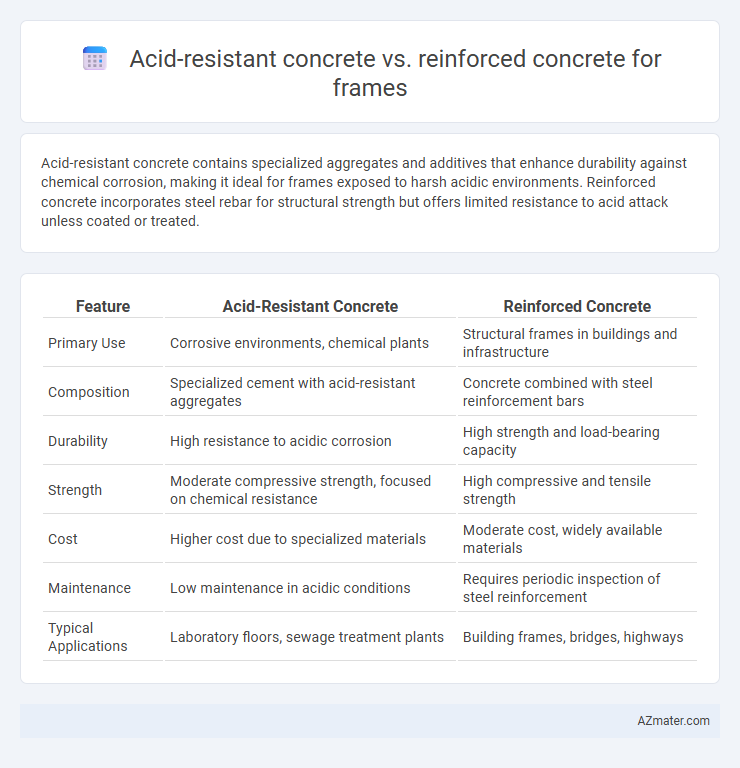Acid-resistant concrete contains specialized aggregates and additives that enhance durability against chemical corrosion, making it ideal for frames exposed to harsh acidic environments. Reinforced concrete incorporates steel rebar for structural strength but offers limited resistance to acid attack unless coated or treated.
Table of Comparison
| Feature | Acid-Resistant Concrete | Reinforced Concrete |
|---|---|---|
| Primary Use | Corrosive environments, chemical plants | Structural frames in buildings and infrastructure |
| Composition | Specialized cement with acid-resistant aggregates | Concrete combined with steel reinforcement bars |
| Durability | High resistance to acidic corrosion | High strength and load-bearing capacity |
| Strength | Moderate compressive strength, focused on chemical resistance | High compressive and tensile strength |
| Cost | Higher cost due to specialized materials | Moderate cost, widely available materials |
| Maintenance | Low maintenance in acidic conditions | Requires periodic inspection of steel reinforcement |
| Typical Applications | Laboratory floors, sewage treatment plants | Building frames, bridges, highways |
Introduction to Concrete Frame Structures
Concrete frame structures rely on a network of beams and columns to support loads, where the choice between acid-resistant concrete and reinforced concrete hinges on environmental exposure and durability requirements. Acid-resistant concrete is engineered with specialized aggregates and chemical admixtures to withstand aggressive chemical environments, making it ideal for industrial facilities with acidic conditions. Reinforced concrete incorporates steel reinforcement to enhance tensile strength, providing robust structural integrity suitable for general construction where chemical resistance is not a primary concern.
Understanding Acid-Resistant Concrete
Acid-resistant concrete is specifically formulated with chemical-resistant aggregates and additives to withstand corrosive environments, making it ideal for frames exposed to acidic substances. Unlike reinforced concrete, which primarily relies on steel reinforcement for structural strength but can suffer corrosion in acidic conditions, acid-resistant concrete ensures durability and longevity without compromising integrity. This specialized concrete reduces maintenance costs and extends the lifespan of structural frames in industrial or chemical applications.
What is Reinforced Concrete?
Reinforced concrete is a composite material combining concrete's compressive strength with steel reinforcement's tensile strength, making it ideal for structural frames. It provides enhanced durability and load-bearing capacity in construction, effectively resisting bending and shear forces. Unlike acid-resistant concrete, which targets chemical durability, reinforced concrete focuses on structural integrity and flexibility in various load conditions.
Key Differences Between Acid-Resistant and Reinforced Concrete
Acid-resistant concrete contains specialized aggregates and chemical additives designed to withstand corrosive environments, making it ideal for industrial applications exposed to acids or harsh chemicals. Reinforced concrete incorporates steel rebar or mesh to enhance tensile strength and structural durability, making it suitable for load-bearing frames in buildings and infrastructure. The primary difference lies in purpose: acid-resistant concrete prioritizes chemical resistance, while reinforced concrete focuses on mechanical strength and structural integrity.
Application Scenarios: When to Use Acid-Resistant Concrete
Acid-resistant concrete is ideal for chemical plants, wastewater treatment facilities, and environments exposed to aggressive acidic chemicals, preventing structural degradation and prolonging lifespan. Reinforced concrete suits general construction such as residential, commercial buildings, and infrastructure where load-bearing capacity is primary, but not acidic exposure. Use acid-resistant concrete specifically when chemical resistance is critical to avoid corrosion and maintain integrity in harsh chemical or acidic conditions.
Performance and Durability Comparison
Acid-resistant concrete exhibits superior chemical resistance compared to reinforced concrete, making it ideal for structures exposed to aggressive acidic environments such as chemical plants and wastewater treatment facilities. Reinforced concrete offers higher tensile strength due to embedded steel reinforcement, which enhances load-bearing capacity but may suffer corrosion in acidic conditions, reducing durability over time. Performance-wise, acid-resistant concrete ensures prolonged structural integrity under chemical attack, whereas reinforced concrete requires protective measures to prevent steel corrosion and maintain durability in similar settings.
Cost Implications of Acid-Resistant vs Reinforced Concrete
Acid-resistant concrete typically incurs higher initial costs than reinforced concrete due to specialized raw materials and manufacturing processes designed to withstand corrosive environments. Reinforced concrete offers a more cost-effective solution for general structural frames, balancing strength and affordability by integrating steel reinforcements. Long-term maintenance expenses for acid-resistant concrete are often lower in aggressive chemical settings, potentially offsetting its upfront cost difference over the lifespan of the structure.
Environmental Resistance and Longevity
Acid-resistant concrete offers superior protection against chemical corrosion, making it ideal for environments exposed to acidic substances, while reinforced concrete excels in structural strength due to embedded steel reinforcement. The longevity of acid-resistant concrete is notably higher in aggressive chemical settings, reducing maintenance and repair costs, whereas reinforced concrete may suffer from steel corrosion if not properly protected. Selecting the appropriate material depends on balancing environmental resistance requirements with structural demands to ensure durability and performance of the frame.
Structural Integrity and Load-Bearing Capacity
Acid-resistant concrete offers enhanced durability in corrosive environments due to its specialized chemical composition, maintaining structural integrity under aggressive acid exposure. Reinforced concrete incorporates steel reinforcement bars, significantly improving its load-bearing capacity and tensile strength, making it ideal for heavy structural frames. Comparing both, acid-resistant concrete excels in chemical resistance, while reinforced concrete provides superior mechanical strength and flexibility under dynamic loads.
Choosing the Right Concrete for Your Project
Acid-resistant concrete is engineered with specialized aggregates and chemical admixtures to withstand corrosive acidic environments, making it ideal for industrial frames exposed to harsh chemicals. Reinforced concrete integrates steel rebars to enhance tensile strength, offering superior load-bearing capacity for structural frames in conventional construction. Selecting the right concrete requires evaluating environmental exposure, load demands, and durability needs to ensure optimal performance and longevity of the structural frame.

Infographic: Acid-resistant concrete vs Reinforced concrete for Frame
 azmater.com
azmater.com